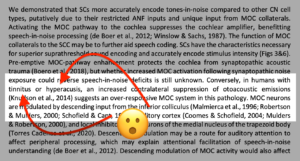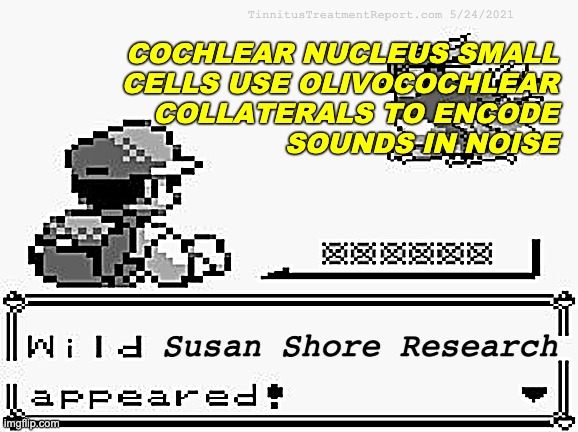Very short update:
A new Susan Shore research paper was just posted online.
It is a preprint (not-yet-peer-reviewed) and was added to bioRxiv a few days ago on May 21, 2021.
The title of the paper is, “Cochlear nucleus small cells use olivocochlear collaterals to encode sounds in noise”. The authors are Susan E. Shore, Calvin Wu, Adam Hockley.
Here is the abstract:
Abstract
Understanding speech, especially in noisy environments, is crucial to social interactions. Yet, as we age, speech processing can be disrupted by cochlear damage and the subsequent auditory nerve fiber degeneration. The most vulnerable-medium and high-threshold-auditory nerve fibers innervate various cell types in the cochlear nucleus, among which, the small cells are unique in receiving this input exclusively. Here, we characterize small cell firing characteristics, demonstrating superior temporal as well as intensity coding. We show that small-cell unique coding properties are facilitated by direct cholinergic input from the medial olivocochlear system. These results highlight the small cell-olivocochlear circuit as a key player in signal processing in noisy environments, which may be selectively degraded in aging or after noise insult.
Here is a link to the full text version (PDF):
https://www.biorxiv.org/content/10.1101/2021.05.20.444983v1.full.pdf
As you probably noticed, the word “tinnitus” is not mentioned up front. Nowhere in title, nowhere in abstract.
But it does appear deeper in the text. As does the word “hyperacusis”, another connection here.

This post is just a quick share. I have not had time to go through the paper and analyze its findings. I only learned about it within the past hour.
But from what I have seen so far, the connections to tinnitus and hyperacusis that Shore references here are quite interesting. And they become more clear once we take a look at the research she cites.
Here is a link to that paper, “Increased contralateral suppression of otoacoustic emissions indicates a hyperresponsive medial olivocochlear system in humans with tinnitus and hyperacusis”:
https://www.ncbi.nlm.nih.gov/pmc/articles/PMC4269714/
That’s all for now. Because it is 12:58 AM here in Montreal, Quebec and I just wanted to share this brand new Susan Shore research preprint update with you before going to bed.
The source of this information:
Like most of the research I post and highlight, this preprint appeared on my radar thanks to the fully automated system that monitors, collects, filters, and organizes the research papers listed on TinnitusTreatmentReport.com. This system runs 24/7 and specifically tracks tinnitus-related research (and news, and clinical trials, and…) from a fairly long list of sources – one of which is bioRxiv, the biology preprint server hosted down at the Cold Spring Harbor Laboratory.
This meme captures the essence of how this system helps me keep up with freshly posted Susan Shore research:

Goodnight.
This update is for Tinnitus Treatment Report email subscribers. If you are reading this but have not yet subscribed — you can join the email updates list here. It’s free. There is no spam. No promotional emails. And your information is kept private. Expect between 1-3 emails per week (but only the good stuff).